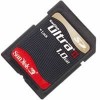SanDisk SDSDH-1024 Product Manual - Page 21
SD Card Interface Description
 |
UPC - 710348911073
View all SanDisk SDSDH-1024 manuals
Add to My Manuals
Save this manual to your list of manuals |
Page 21 highlights
Revision 2.2 Chapter 3 - SD Card Interface Description SD Card Product Manual 3 SD Card Interface Description 3.1 General Description of Pins and Registers The SanDisk SD Card has nine exposed contacts on one side as shown in Figure 3-1. The host is connected to the card using a dedicated 9-pin connector. Table 3-1 Pin No. SD Mode 1 2 3 4 5 6 7 8 9 SPI Mode 1 2 3 4 5 6 7 8 9 SD Card Pad Assignment Name Type1 Description CD/DAT32 CMD VSS1 VDD CLK VSS2 DAT0 DAT1 DAT2 I/O3, PP I/O, PP S S I S I/O, PP I/O, PP I/O, PP Card detect/Data line [Bit 3] Command/Response Supply voltage ground Supply voltage Clock Supply voltage ground Data line [Bit 0] Data line [Bit 1] Data line [Bit 2] CS DataIn VSS1 VDD CLK VSS2 DataOut RSV4 RSV5 I Chip Select (active low) I Host-to-card Commands and Data S Supply voltage ground S Supply voltage I Clock S Supply voltage ground O Card-to-host Data and Status --- Reserved --- Reserved 1 Type Key: S=power supply; I=input; O=output using push-pull drivers; PP=I/O using push-pull drivers 2 The extended DAT lines (DAT1-DAT3) are input on power up. They start to operate as DAT lines after the SET_BUS_WIDTH command. It is the responsibility of the host designer to connect external pullup resistors to all data lines even if only DAT0 is to be used. Otherwise, non-expected high current consumption may occur due to the floating inputs of DAT1 & DAT2 (in case they are not used). 3 After power up, this line is input with 50Kohm(+/-20Kohm) pull-up (can be used for card detection or SPI mode selection). The pull-up may be disconnected by the user, during regular data transfer, with SET_CLR_CARD_DETECT (ACMD42) command. 4 The 'RSV' pins are floating inputs. It is the responsibility of the host designer to connect external pullup resistors to those lines. Otherwise non-expected high current consumption may occur due to the floating inputs. 5 Ibid. © 2004 SanDisk Corporation 3-1 12/08/04















